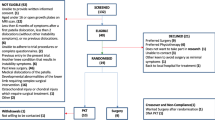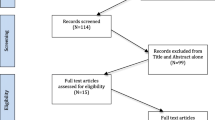Abstract
Purpose
To determine the prevalence and change in neuropathic pain or pain catastrophizing before and 12 months following patellar stabilisation surgery for patellofemoral instability.
Methods
We conducted a prospective clinical audit within a UK NHS orthopaedic surgical centre. Data from 84 patients with patellofemoral instability requiring stabilisation were analysed. Fifty percent (42/84) underwent MPFL reconstruction alone, and 16% (13/84) had both trochleoplasty and MPFL reconstruction. Neuropathic pain was assessed using painDETECT score. Pain catastrophizing was assessed using the Pain Catastrophizing Score. The Norwich Patellar Instability (NPI) Score and Kujala Patellofemoral Disorder Score were also routinely collected pre-operatively and one year post-operatively.
Results
At 12 months post-operatively there was a statistically significant reduction in mean Pain Catastrophizing Scores (18.9–15.7; p < 0.02), but no change in mean painDETECT scores (7.3–7.8; p = 0.72). There was a statistically significant improvement in NPI scores (90.2–61.9; p < 0.01) and Kujala Patellofemoral Disorder Scores (48.7–58.1; p = 0.01). The prevalence of pain catastrophizing decreased from 31% pre-operatively to 24% post-operatively, whereas the prevalence of neuropathic pain remained consisted (10–11%).
Conclusions
Neuropathic pain and catastrophizing symptoms are not commonly reported and did not significantly change following patellofemoral stabilisation surgery. Whilst low, for those affected, there remains a need to intervene to improve outcomes following PFI surgery.
Similar content being viewed by others
Data availability
Data and statistical code will be released on reasonable request to the corresponding author.
References
Nietosvaara Y, Aalto K, Kallio PE (1994) Acute patellar dislocation in children: incidence and associated osteochondral fractures. J Ped Orthop 14:513–515
Saccomanno MF, Sircana G, Fodale M, Donati F, Milano G (2016) Surgical versus conservative treatment of primary patellar dislocation. A systematic review and meta-analysis. Int Orthop 40:2277–2287
Atkin DM, Fithian DC, Marangi KS, Stone ML, Dobson BE, Mendelsohn C (2000) Characteristics of patients with primary acute lateral patellar dislocation and their recovery within the first 6 months of injury. Am J Sports Med 28:472–479
Fithian DC, Paxton EW, Stone ML, Silva P, Davis DK, Elias DA, White LM (2004) Epidemiology and natural history of acute patellar dislocation. Am J Sports Med 32:1114–1121
Bolgla LA, Boling MC, Mace KL, DiStefano MJ, Fithian DC, Powers CM (2018) National Athletic Trainers’ Association Position Statement: Management of individuals with Patellofemoral Pain. J Athlet Training 53:820–836
Sanders TL, Pareek A, Hewett TE, Stuart MJ, Dahm DL, Krych AJ (2018) High rate of recurrent patellar dislocation in skeletally immature patients: a long-term population-based study. Knee Surg Sports Traumatol Arthrosc 26(4):1037–1043
McGuine TA, Winterstein AP, Carr K, Hetzel S (2014) Changes in health-related quality of life and knee function after knee injury in young female athletes. Orthop J Sports Med 2(4):2325967114530988
Smith TO, Donell ST, Chester R, Clark A, Stephenson R (2011) What activities do patients with patellar instability perceive makes their patella unstable? Knee 18:333–339
Magnussen RA, Verlage M, Stock E, Zurek L, Flanigan DC, Tompkins M et al (2015) Primary patellar dislocations without surgical stabilization or recurrence: how well are these patients really doing? Knee Surg Sports Traumatol Arthrosc:2–6.
Smith TO, Donell ST, Clark A, Chester R, Cross J, Kader DF et al (2014) The development, validation and internal consistency of the Norwich Patellar Instability (NPI) score. Knee Surg Sports Traumatol Arthrosc 22:324–335
Smith TO, Donell S, Song F, Hing CB (2015) Surgical versus non-surgical interventions for treating patellar dislocation. Cochrane Database Syst Rev 26:CD008106
Subramanian P, Patel R (2016) Patellofemoral instability: an overview. Orthop Traumatol 33:119–126
Rhee SJ, Pavlou G, Oakley J, Barlow D, Haddad F (2012) Modern management of patellar instability. Int Orthop 36:2447–2456
Fingleton C, Smart K, Moloney N, Fullen BM, Doody C (2015) Pain sensitization in people with knee osteoarthritis: a systematic review and meta-analysis. Osteoarthr Cartil 23:1043–1056
Thakur M, Dickenson AH, Baron R (2014) Osteoarthritis pain: nociceptive or neuropathic? Nat Rev Rheumatol 10:374–380
Woolf CJ (2011) Central sensitization: implications for the diagnosis and treatment of pain. Pain 152:S2–S15
Callin S, Bennett MI (2008) Assessment of neuropathic pain. Contin Educ Anaesth Crit Care Pain 8:210–213
Buchanan G, Torres L, Czarkowski B, Giangarra CE (2016) Current concepts in the treatment of gross patellofemoral instability. Int J Sport Phys Ther 11:867–876
de Oliveira V, de Souza V, Cury R, Camargo OP, Avanzi O, Severino N, Fucs P (2014) Medial patellofemoral ligament anato- my: is it a predisposing factor for lateral patellar dislocation? Int Orthop 38:1633–1639
Goubert D, Danneels L, Cagnie B, Van Oosterwijck J, Kolba K, Noyez H et al (2015) Effect of pain induction or pain reduction on conditioned pain modulation in adults: a systematic review. Pain Pract 15:765–777
Klyne DM, Schmid AB, Moseley GL, Sterling M, Hodges PW (2015) Effect of types and anatomic arrangement of painful stimuli on conditioned pain modulation. J Pain 16:176–185
Kurien T, Arendt-Nielsen L, Petersen KK, Graven-Nielsen T, Scammell BE (2018) Preoperative neuropathic pain-like symptoms and central pain mechanisms in knee osteoarthritis predicts poor outcome 6 months after total knee replacement surgery. J Pain 19:1329–1341
Christensen KS, O’Sullivan K, Palsson ST (2020) Conditioned pain modulation efficiency is associated with pain catastrophizing in patients with chronic low back pain. Clin J Pain 36:826–832
Quartana PJ, Campbell CM, Edwards RR (2009) Pain catastrophizing: a critical review. Expert Rev Neurother 9:745–758
Burns LC, Ritvo SE, Ferguson MK, Clarke H, Seltzer Z, Katz J (2015) Pain catastrophizing as a risk factor for chronic pain after total knee arthroplasty: a systematic review. J Pain Res 8:21–32
Lewis GN, Rice DA, McNair PJ, Kluger M (2015) Predictors of persistent pain after total knee arthroplasty: a systematic review and meta-analysis. Br J Anaesth 114:551–561
Sanchis-Alfonso V, Puig-Abbs C, MartÍnez-Sanjuan V (2011) Evaluation of the patient with anterior knee pain and patellar instability. In: Sanchis-Alfonso V (ed) Anterior knee pain and patellar instability. Springer, London, pp 105–133
Thompson P, Metcalfe AJ (2019) Current concepts in the surgical management of patellar instability. Knee 26:1171–1181
Beighton PH, Horan F (1969) Orthopedic aspects of the Ehlers-Danlos syndrome. J Bone Joint Surg [Br] 51:444–453
Reider B, Marshall JL, Warren RF (1981) Clinical characteristics of patellar disorders in young athletes. Am J Sports Med 9:270–274
Sheehan FT, Derasari A, Fine KM, Brindle TJ, Alter KE (2010) Q-angle and J-sign: indicative of maltracking subgroups in patellofemoral pain. Clin Orthop Relat Res 468:266–275
Sullivan MJL, Bishop S, Pivik J (1995) The Pain Catastrophizing Scale: Development and validation. Psychol Assess 7:524–532
Freynhagen R, Baron R, Gockel U, Tolle TR (2006) painDETECT: a new screening questionnaire to identify neuropathic components in patients with back pain. Curr Med Res Opin 22:1911–1920
Kujala UM, Jaakkola LH, Koskinen SK, Taimela S, Hurme M, Nelimarkka O (1993) Scoring of patellofemoral disorders. Arthroscopy 9:159–163
Bennett MI, Attal N, Backonja MM et al (2007) Using screening tools to identify neuropathic pain. Pain 127:199–203
Bouhassira D, Attal N (2011) Diagnosis and assessment of neuropathic pain: the saga of clinical tools. Pain 152(3 Suppl):S74-83
Lavand’homme PM, Grosu I, France MN, et al (2014) Pain trajectories identify patients at risk of persistent pain after knee arthroplasty: an observational study. Clin Orthop Relat Res 472:1409–1415
Priore LB, Azevedo FM, Pazzinatto MF, Ferreira AS, Hart HF, Barton C et al (2019) Influence of kinesiophobia and pain catastrophism on objective function in women with patellofemoral pain. Phys Therap Sport 35:116–121
Jockimsen KN, Pelton MR, Mattacloa CG, Huston LJ, Reinke EK, Spindler KP et al (2019) Relationship between pain catastrophizing and 6-month outcomes following anterior cruciate ligament reconstruction. J Sport Rehabil 18:1–5
Campbell CM, Buenaver LF, Finan P, Bounds SC, Redding M, McCauley L, Robinson M et al (2015) Sleep, pain catastrophizaing and central sensitization in knee osteoarthritis patients with and without insomnia. Arthritis Care Res 67:1387–1396
Jensen R, Hystad T, Kvale A, Baerheim A (2007) Quantitative sensory testing of patients with long lasting patellofemoral pain syndrome. Eur J Pain 11:665–676
Sulllivan MJL, Stanish W, Waite H, Sullivan M, Tripp DA (1998) Catastrophizing, pain and disability in patients with soft-tissue injuries. Pain 77:253–260
Funding
The authors received no funding to undertake this work.
Author information
Authors and Affiliations
Contributions
Toby O Smith: Study analysis, preparation and review of the manuscript.
Aliya Choudhury: Data gathering, study analysis and preparation of the manuscript.
Joshua Fletcher: Preparation and review of manuscript.
Zareen Choudhury: Preparation and review of manuscript.
Michael Mansfield: Preparation and review of manuscript.
Duncan Tennent: Preparation and review of manuscript.
Caroline B Hing: Study design, preparation and review of the manuscript.
Corresponding author
Ethics declarations
Ethical approval
Approval for this clinical audit was obtained from the XXXXX Hospital (XXXXX) Clincal Audit Department (Ref: AUDI000887).
Consent to participants
Consent for participants was obtained as part of the audit approval consent processes.
Consent for publication
Consent for publication from participants was obtained as part of the audit approval consent processes.
Conflict of interest
No conflict of interest to declare.
Additional information
Publisher's Note
Springer Nature remains neutral with regard to jurisdictional claims in published maps and institutional affiliations.
Rights and permissions
About this article
Cite this article
Smith, T.O., Choudhury, A., Fletcher, J. et al. Changes in pain catastrophization and neuropathic pain following operative stabilisation for patellofemoral instability: a prospective study with twelve month follow-up. International Orthopaedics (SICOT) 45, 1745–1750 (2021). https://doi.org/10.1007/s00264-021-05046-w
Received:
Accepted:
Published:
Issue Date:
DOI: https://doi.org/10.1007/s00264-021-05046-w




